Bridging the Gap
Jamey Barbas BS’83 is changing the face of New York City.
As project director of the New NY Bridge—which will replace the aging, crumbling Tappan Zee Bridge connecting Rockland and Westchester Counties—Jamey Barbas is overseeing a project that’s long on complexity and short on time. But that’s exactly the kind of project where she thrives.
“I’ve always gravitated toward things that are difficult in structure and engineering, and innovative in procurement,” she said.
Commissioned in 2014 after 15 years of discussion, the New NY Bridge was fast-tracked after President Obama made the nation’s failing infrastructure a priority and put the Tappan Zee near the top of the list. At 60 years old and carrying almost 140,000 vehicles a day, the bridge has outlived its expected use and is handling far more traffic than was intended.
Barbas joined the team in 2015. Her expertise in building long-span bridges (at 3.1 miles, the Tappan Zee is the longest bridge in New York State) and in navigating issues (the bridge crosses the water at its widest part, there are multiple protected species in the area, and the riverbed is like “tapioca pudding,” Barbas said) has served her well in a job laden with complexities. The $3.98 billion project to replace the seven-lane, 60-year-old structure is a design/build job—a nontraditional arrangement that lets the developers, the City, and the engineers work in tandem to complete the job as quickly as possible.
It’s a way of working that Barbas knows well.
“I specialize in alternative delivery, which is design/build, and public/ private partnerships, which is another way of putting projects together—it’s like design/build on steroids,” she said.
Barbas first got the bug for bridges after college and, in fact, was introduced to the Engineering School almost by accident.
As a Barnard student, she enrolled “across the street” for a bioengineering class and got hooked, she said. Barbas joined SEAS and after graduating with a BS in 1983, she started work at a transportation consulting firm.
Columbia, she remarked, gave her that first taste of the industry—and a closer look at the structures that shape New York City.

Jamey Barbas
(Photo courtesy of Jamey Barbas)
“My professors were amazing,” she said. “And they had some really interesting relationships with private contractor organizations. I remember going on a trip sponsored by the Moles organization, where they took us on a field visit inside the Archer Avenue tunnel while it was being built. Those experiences leave an impression.”
The New NY Bridge incorporates other unique features besides its financing and fast-tracking. The foundations and roadway were designed to accommodate a rail line, should one be desired down the road. The bridge also has embedded sensors that can give engineers feedback almost immediately if something isn’t right—what Barbas called, “the most comprehensive structural health-monitoring system for a bridge in the U.S.”
Barbas said the team is sensible of their responsibility to the public in another way: Building a bridge in a city that takes justifiable pride in its instantly recognizable structures is no small task. And as a native New Yorker, she’s got a personal interest.
“The look of the bridge was important to the owner and the public. We knew we wanted to have a signature, or iconic, structure,” Barbas said.
The eye-catching, twin-span cable-stayed design (the new bridge is actually two bridges, one for each direction) is part of the equation—but only part, she noted.
“We do think about the public all the time—they’re the end users, and our neighbors too. So that’s the aim: to put something out there that will serve the public.”
That meant adding a pedestrian-shared space and a bike area (which the old Tappan Zee lacked), as well as lookouts with decor created by local artists.
Seeing that vision begin to rise up from the Hudson, Barbas said, is hugely gratifying.
“It’s the most amazing project in New York,” she added. “And I’m happy to lead a new major bridge project right in my own backyard.”

Jamey Barbas
(Photo courtesy of Jamey Barbas)
